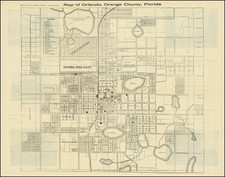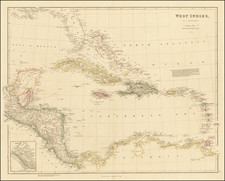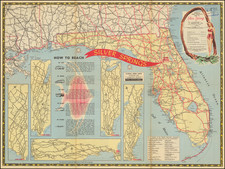Only Example Traced.
One of the Earliest Separate Maps of Miami Beach.
This map, rendered in the clear hand of engineer Karl Squires, is an important representation of the burgeoning community of Miami Beach in September 1924. Covering the entirety of Miami Beach and delineating both its man-made and natural geographical features, this map offers a window into the city's development and topography at the end of its first decade of existence.
Karl Squires was responsible for much of the county and municipality mapping going on in Florida during the 1920s boom years. His career stretched into the 1930s.
Fisher Island (still called Virginia Key at this point) is labeled "Under Peninsula Terminal Company Development". Part of the island is still a government reservation. On the other side of Government Cut, another government reservation is shown at what is now South Pointe Park.
The Flamingo Course and Miami Beach Golf Course have given way to smaller parks and other amenities. The Bay Shore Golf Course still exists in the form of the Miami Beach Golf Club. Polo Fields in the northern section of the map have since been converted into the Nautilus neighborhood.
Initial addition and subdivision names are listed. Blocks are numbered. Lot numbers and dimensions are given across the entire city.
The map has a series of insets, primarily covering the so-called Biscayne Bay Islands of Palm and Hibiscus, as well as San Marco, San Marino, Di Lido, and Rivo Alto. Star Island and Belle Isle are shown in detail on the primary map.
Miami Beach History
Founded in 1915, the City of Miami Beach began its journey as a dreamy, sun-drenched paradise off the coast of mainland Miami. Its first decade saw rapid development, transitioning from a mangrove-filled barrier island to a premier winter vacation destination. Pioneers like John S. Collins and Carl G. Fisher played instrumental roles in its transformation, with Fisher marketing the city as "America's Playground." The construction of the Collins Bridge in 1913, recognized as the longest wooden bridge in the world at the time, was pivotal in connecting the city to the mainland and facilitating its growth. In the 1920s, Miami Beach underwent a construction boom, with iconic hotels and lavish estates springing up, laying the foundation for its enduring reputation as a glamorous getaway.
Rarity
Not in OCLC nor the Touchton Map Library. We are unable to trace another example of the map.
While the Sanborn Map Company produced atlas-format insurance maps of Miami Beach from at least 1918, separate maps of the city from before 1930 are exceptionally rare today. This is the earliest such map that we have encountered, though, given the city's founding 9 years prior, there are bound to be earlier maps.














![[ Florida / Georgia Coastline ] A Plan of Amelia Harbour and Bar, in East Florida, Surveyed by Jacob Blamey, Master of His Majesty's Schooner St. John](https://storage.googleapis.com/raremaps/img/small/38028.jpg)
![[ Florida / Great Hurricane of 1926 ] West Hollywood After the Hurricane Sept. 1926](https://storage.googleapis.com/raremaps/img/small/101965.jpg)
![[Florida to New Orleans] The North Coast of the Gulf of Mexico from St. Marks to Galveston . . . 1842](https://storage.googleapis.com/raremaps/img/small/83469.jpg)